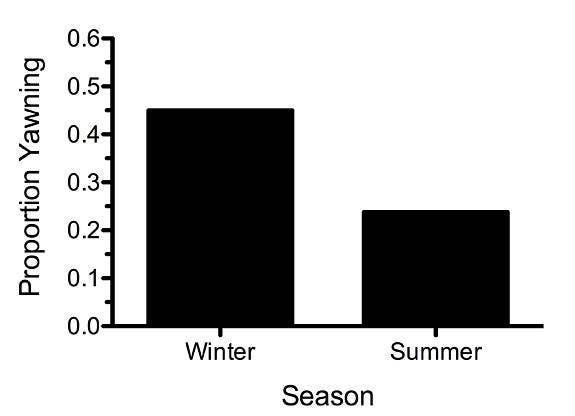We all yawn from time to time, and yet we know surprisingly little about what yawning is, why we do it, and why it’s contagious.
We’re still not sure why we yawn, but the only demonstrated function of yawning has been to help thermoregulate the brain.
What is yawning?

Humans yawn, all vertebrates yawn, even fetuses yawn in the womb. We’ve all seen and experienced it countless times, but what is yawning, really? Technically, it’s a reflex through which we simultaneously inhale air and stretch our eardrums (which is why yawning helps when you have stuffy ears). Your abdominal muscles flex, your diaphragm is pushed down, and the air you breathe in expands the lungs to capacity. Then, you exhale. What a weird thing to do!
It’s an involuntary motion (we know it’s involuntary not only because you can’t control it, but also because we do it before even being born), and a very common one: we do it most often when we wake up or before we go to sleep, but we also do it when we’re tired. We even yawn while we sleep.
Culturally, yawning has also become associated with boredom or stress.
Why we yawn
Since time immemorial, humans have had hypotheses about why we yawn. More than 2,000 years ago, the Greek “Father of Medicine” Hippocrates believed that yawning occurs before a disease or infection and helps to eliminate the “bad air” from the lungs.
This understanding was challenged in the 17th and 18th centuries when doctors started suggesting that yawning causes an increase in blood pressure, heart rate, and oxygen in the blood. This would apparently make sense because yawning seems to be associated with tiredness and blood pressure and heart rate go down when we sleep.
However, modern studies have not found any evidence of any of these processes. To the best of our current medical knowledge, this is nothing more than a myth.
More recently, research has found that yawning is “associated with the change of a behavioral state- wakefulness to sleep, sleep to wakefulness, boredom to alertness,” but the nature of this association is indirect.
Increasingly, studies have shown that yawning is used as a thermoregulation mechanism. In order to function properly, our organs need to have the right temperature — and the brain is particularly vulnerable to temperature changes. Although it’s relatively small, the human brain uses approximately 40% of our metabolic energy, which means it’s also more likely to overheat. When we yawn, we ingest a gulp of air that goes into contact with our nasal and oral cavities, which are directly linked to the brain through countless blood vessels. Furthermore, when we stretch our jaws, we increase the blood flow to the brain, which helps the relatively colder air slightly reduce the temperature of our brains.
So essentially, yawning could be a way to adjust the temperature of our brains.

Researchers from the University of Vienna have found that pedestrians at some temperatures are much more likely to yawn. Andrew Gallup, a psychology professor at SUNY College at Oneonta, also found that holding hot or cold packs to the forehead influenced how often people yawn. A study on two women suffering from chronic, debilitating bouts of yawning also found that the symptoms can be alleviated by applying a cool cloth to their forehead.
Studies on mice have also demonstrated the cooling mechanism: yawning is preceded by an increase in brain temperature, and after yawning the brain temperature decreases.

Social yawning and contagion
The reasons for yawning might also be social. It might be a social cue that we’re tired, about to go to bed, or just got awake. It could also be an indication of boredom, that we’re not finding our current situation interesting or exciting. In evolutionary terms, yawning might be a herd instinct, and there seems to be a cultural component to yawning, since elements such as nationality and gender influence how often we yawn.
Yawning is also contagious, being potentially triggered by seeing, hearing, or even thinking about someone else yawning.
The interesting thing is that contagious yawning does not occur in species that do not recognize themselves in mirrors or in infants younger than two years old
A good way to start understanding this phenomenon is to look at those who exhibit it. If you see someone yawning next to you — even if it’s different species like your pet — you will, at least sometimes, start to yawn — unless you’re a psychopath, that is. In a recent study, which again emphasized the different roles of yawning, researchers showed that psychopaths don’t really respond to yawning contagion. This also indicates that yawning is related to empathy.
Another group that doesn’t typically get “infected” by yawning is autistic children, though in this case, the cause is their lack of attention to social cues rather than a lack of empathy.
So why is it that all but a very few groups of people pass yawning around?
Empathy seems to be the crucial aspect. Studies have shown that the more empathic you are, the more likely you are to “catch” yawning. Similarly, the less empathy you have, the less likely you are to do so. Overall, yawning is contagious in 60-70% of people, even from images or other species, one study reports. However, another study found that only 42-55% of people yawned when they were shown a videotape of another person repeatedly yawning.
Furthermore, fMRI scans have shown that the posterior cingulate and precuneus light up during contagious yawning — two areas connected to how we interpret the emotions of others, underscoring the link between empathy and yawning.
Other theories
There are a few other reasonable theories regarding yawning. For instance, one postulates that animals in danger of predation need to constantly be alert, to be able to quickly avoid danger if it emerges.
Another hypothesis suggests that yawns are caused by neurotransmitters — chemical messengers released by brain cells that affect emotions, mood, appetite, and other phenomena. As more (or fewer) of these compounds are activated in the brain, the frequency of yawning increases. A piece of evidence to support this is the fact that people in opioid withdrawal tend to yawn much more frequently than normal. To further back this theory, in neuropharmacology, yawning proved to be a valuable tool for assessing dopaminergic activity and the pharmacological properties of new drugs.
Stress is another potential cause of yawning. There is plenty of anecdotal evidence of yawning before a stressful event, even in the case of paratroopers, who were often reported to yawn right before jumping. At least one study reported that yawning might make the brain more alert.
Yawning can also be affected by medical conditions such as diabetes or stroke.
The bottom line
The precise role of yawning in human physiology remains unclear.
Overall, it seems that the myths about yawning aren’t really true. Instead, the phenomenon seems to have a multitude of potential triggers, which quite likely work together to generate yawning. There is both a biological and a social component to yawning, and most humans (as well as many other vertebrates). As for how this behavior evolved and came to be, the verdict is still out.






